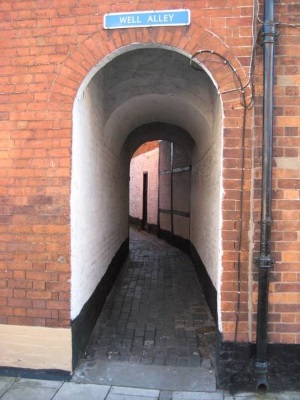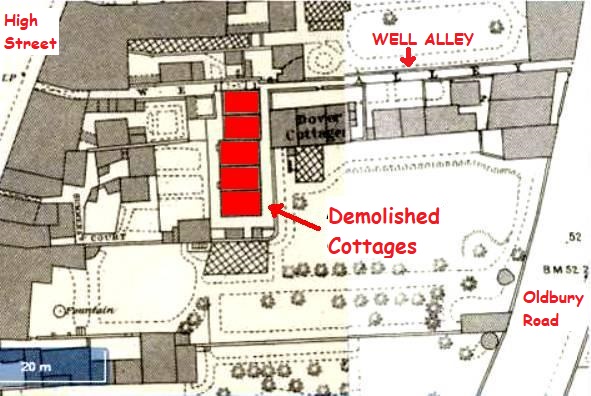Well Alley

Though the entrance passage appears to pass through No 73, the alley is really behind No 74. The absence of cottages on the left confirm this. There’s no evidence for how and when, but the passage area must have been transferred from one house to the other sometime in the past. Presumably whilst they were in common ownership. The High Street in this area is a happy mixture of small houses and grand mansions. Most of the Georgian fronts are hiding timber frames. Except for Summer’s Court, where no modernisation took place at all.
The symmetry of the plots was broken well before the time when mapping gave us information about past layouts. Hereford House had a garden which occupied a space between what is now the Roses Theatre and the back of the Well Alley cottages. Well Alley had a court extending at right-angles behind Summer’s Court, containing five cottages. A clearance order in 1955 saw their demolition. There is no trace of them now, the land being incorporated into the front house garden.
Earlier cottages may have existed along the upper part of the alley, but if they did they were demolished centuries ago. In 1833, the sale of what is now Hereford House refers to a garden owned by L.G. Senior, part of which was sold off in lots and built upon. This must be Dover Cottages and the neighbouring block. They remain today, with small front gardens, and a sense of order which didn’t exist in most alleys, so admired by the Town Vigilance Committee.
Well Alley’s most famous resident was William Sandilands. Born in about 1780, he went to sea on merchant ships before being impressed into the Royal Navy whilst at Milford Haven. He was posted to the Victory, and at the Battle of Trafalgar he was a gun captain. He saw Nelson fall, and was one of those who helped carry him to the cockpit for treatment. He was there when he died. William continued in the Navy until the end of the wars, in 1814 and was discharged without a pension. He came home to Tewkesbury where he settled down, being employed on the roads. He hit hard times, and on the intercession of Rev. Croker Lady Nelson provided him with a pension of 2s a week from her own resources. When she died, the pension stopped. The Guardians of the Poor agreed to substitute his pension, and an appeal through the ‘Times’ raised a sum to allow him comforts like a ‘pipe and a pot’. He died in 1867, reputedly the last survivor of the Victory’s crew. He has a memorial in Holy Trinity Church.Today, there are still nice gardens and cottages. Even the wall of the tyre workshop isn’t intrusive.

An article in the ‘Register’ in May 1964 headlined a report on the state of the town centre by the ‘Vigilance Committee’. It was pretty damning, and spoke mostly of decay and neglect. It did say, though ‘Attention is drawn to Well Alley with its very nice gardens and cottages and shows what can be accomplished.’ Not much has changed in Well Alley since then.
Maybe it looks as if it is, but it isn’t a typical Tewkesbury Alley. It doesn’t follow the principles for a straightforward developed burgage plot, with a passage through from the ‘front’ house and cottages in a row behind, and puzzling out what has happened over the years involves some guesswork as well as research.
It is one of the few alleys which isn’t called after the owner of the front house. Wells are a very common feature of alleys, so this must have been a special well. In his memories of the alleys, John Rogers suggested that the well, which then still existed in a garden at the Oldbury end, was the source of water for a settlement pre-dating the High Street, and which might have been connected to the Roman settlement in the Oldbury. All things are possible!


Comments